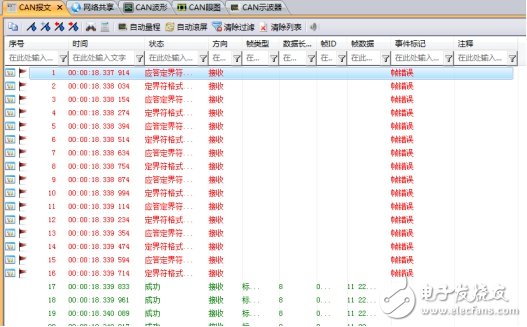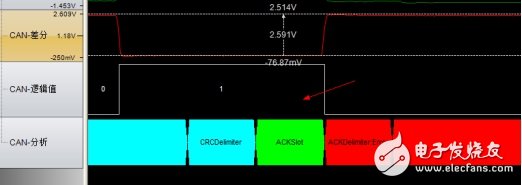During the CAN bus debugging process, the message transmission failed. Many engineers know that they do not know it. Here we will discuss the failure of CAN message transmission.
Before we understand why CAN messages fail to be sent, let's look at what a correct CAN message should look like. Table 1 is a packet of a normal standard data frame.
Table 1 Standard data frame packet format


Figure 1 Standard data frame format
The CAN bus is a broadcast-based communication method. In order to ensure that every normal node on the bus can correctly receive the message, the sender of the message requires each receiving node to respond before the message is sent. It is also the reason why the ACK exists in the message.
The length of the ACK segment in a frame of CAN messages is 2 bits, including the ACK Slot and the ACK Delimter. In the response field, the transmitting station sends two recessive bits. When the receiver correctly receives a valid message, the receiver sends a "dominant" bit to the sender during the acknowledgment gap (ACK Slot) to indicate the response.
Acknowledge gap: All stations that receive a matching CRC sequence (CRC SEQUENCE) will respond with an explicit bit written to the transmitter's recessive bit during the ACK Slot.
Response Delimiter: The ACK delimiter is the second bit of the ACK field and is a bit that must be recessive. Therefore, the ACK Slot is surrounded by two recessive bits, namely the CRC Delimter and the ACK Delimter.

Figure 2 Normal ACK segment message
If there is no ACK response on the bus (that is, the response gap is recessive), the sender will send an error flag, and the error counter value will be increased by 8, and the node will automatically retransmit the message. If the automatic retransmission is still received. If the ACK is not received, the error counter will be actively changed to the error passive state after the error counter count reaches 128 (that is, 16 frames of error frames appear), as shown in Figure 3.
What are the reasons for the ACK segment error?· There is only one valid node on the bus: the node that sends the message will detect the status of the response gap on the bus after sending out a frame message. If the response gap is detected as a recessive bit, it means that the frame message does not get an ACK. The transmission fails and needs to be resent, and since the send error counter will accumulate after the transmission fails until the node is closed. Therefore, when there is only one valid node on the bus, this node can not send out data, because the ACK Slot in the data frame it sends has no other node to fill, it will always be a recessive bit, and this node will always be heavy. Send data until the transmission is successful or the transmission is cancelled.
· The baud rate does not match or the node is not initialized, resulting in no ACK;
· Bus cable short circuit, open circuit, reversed;
· The node connected to the high-speed CAN bus is not a high-speed CAN, but a fault-tolerant low-speed CAN, resulting in a mismatch.

Figure 3 response delimiter error frame

Figure 4: Message without ACK
When you fail to send a message when the CAN bus is debugged, be sure to check if the above mentioned omissions cause an ACK exception on your bus. With the right instrument, you can do more with less when looking for CAN bus errors. Figure 4 uses the CANScope of Zhiyuan Electronics to mark the error frame and find the waveform corresponding to the error frame to find the error condition. CANScope can also perform a series of tests on the physical layer, data link layer and application layer of the CAN bus to solve the test problems for CAN engineers.

Figure 5 CANScope test project
There are a few different types of slip rings, but the most common type is called a cap slip ring. Cap slip rings have a cylindrical housing with an internal flange that fits over the end of the shaft. They typically have 6 or 12 channels and are available in a wide range of sizes.
Cap slip rings are used to provide electrical power and signals to and from rotating equipment. The channels on the slip ring allow for the passage of current and/or data signals through the ring. This allows for the rotation of devices such as antennae, radar dishes, and wind turbines without having to interrupt or disconnect the power or signal lines.
Cap slip rings are very reliable and can handle high speeds and heavy loads. They are also easy to install and maintain.
In the modern world, companies are always looking for ways to improve the efficiency of their machines and operations. Oubaibo offers a variety of products that can help improve your machine's performance. Their Cap Slip Ring allows for high-speed rotary unions, while their high-pressure swivel joints can handle even the most strenuous industrial applications. With so many options available, there's sure to be an Oubaibo product that can improve your machine's performance.
Cap Slip Ring,High Speed Rotary Unions,High Pressure Swivel Joints,High Pressure Swivel Joint
Dongguan Oubaibo Technology Co., Ltd. , https://www.sliproubos.com
